Executive summary
Explore our concise guide’s key customer service goals essential for business success. Learn how to set practical targets and measure progress to enhance customer interactions and boost satisfaction. This blog provides actionable insights and examples of customer service goals to help businesses prioritize and achieve customer service excellence, fostering loyalty and driving growth.
Setting precise customer service goals is fundamental in today’s business landscape, where every customer interaction counts. These goals act as navigational beacons, guiding service teams to deliver consistent, high-quality experiences that meet evolving customer expectations. Statistics reveal a compelling narrative: 91% of customers are likely to make repeat purchases after an excellent service experience, and 63% anticipate personalized attention from service agents. These figures underscore the necessity of establishing robust customer service benchmarks.
Integrating technology, particularly AI and analytics, is reshaping customer service. These tools streamline operations and offer deeper insights into customer needs and behaviors. Our discussion will highlight how leveraging technology, alongside well-defined service goals, can create a more efficient, responsive, and customer-centric service environment. By aligning your team with these essential service objectives, your business can enhance customer satisfaction, cultivate loyalty, and drive sustainable growth.
Related must-reads:
- 10 Top customer service expectations to guide your strategy
- Omnichannel customer service – [Strategy + Examples]
- The complete guide to customer service best practices
- 10 Key elements of effective customer service
Why do you need to set customer service goals?
Setting customer service goals is a strategic imperative for any business. These goals are the compass for your service team, ensuring every customer interaction is steered towards excellence and alignment with broader business objectives. But why is this alignment so crucial, and how does it resonate with business needs today?
1. Guiding compass for strategy and performance: Just like a compass in the hands of a navigator, customer service goals provide direction and focus. They help businesses chart the course for service quality, ensuring that every team member understands their role in the journey towards customer satisfaction.
2. Enhanced team autonomy and decision-making: When goals are clear, team members gain the confidence to make informed decisions independently. This autonomy speeds up response times and fosters a proactive problem-solving culture within the team.
3. Benchmark for excellence: Setting customer service goals establishes a benchmark against which performance can be measured. It aids in managing team performance and identifying areas for individual and collective improvement.
4. Synchronization of efforts: Goals act as a unifying force, aligning the actions and efforts of individuals across the organization. This synchronization ensures that everyone, from frontline agents to senior managers, contributes to the collective success of the business.
5. Continuous improvement: Goals are not just about meeting immediate targets but about setting the stage for ongoing service quality enhancement. By focusing on specific areas of improvement, businesses can ensure a consistent upward trajectory in customer service excellence.
6. Reflecting business evolution: In today’s dynamic market landscape, where customer expectations are constantly evolving, having defined service goals helps businesses stay ahead. It enables them to adapt and evolve their service strategies to fit changing customer needs and industry trends.
7. Driving business growth and customer loyalty: Well-crafted customer service goals ultimately lead to improved customer experiences, fostering loyalty and encouraging repeat business. Businesses can secure a competitive edge and drive sustainable growth by consistently meeting and exceeding customer expectations.
Productivity increases for Hyundai agents

How to set and measure customer service goals?
Mastering the art of setting and measuring customer service goals is akin to charting a clear path through the complex terrain of customer expectations and business objectives. This precision ensures that every step taken aligns with overarching business goals, enhancing customer satisfaction and driving organizational success. Let’s delve into how businesses can adeptly set and monitor these vital goals.
1. Embrace SMART objectives
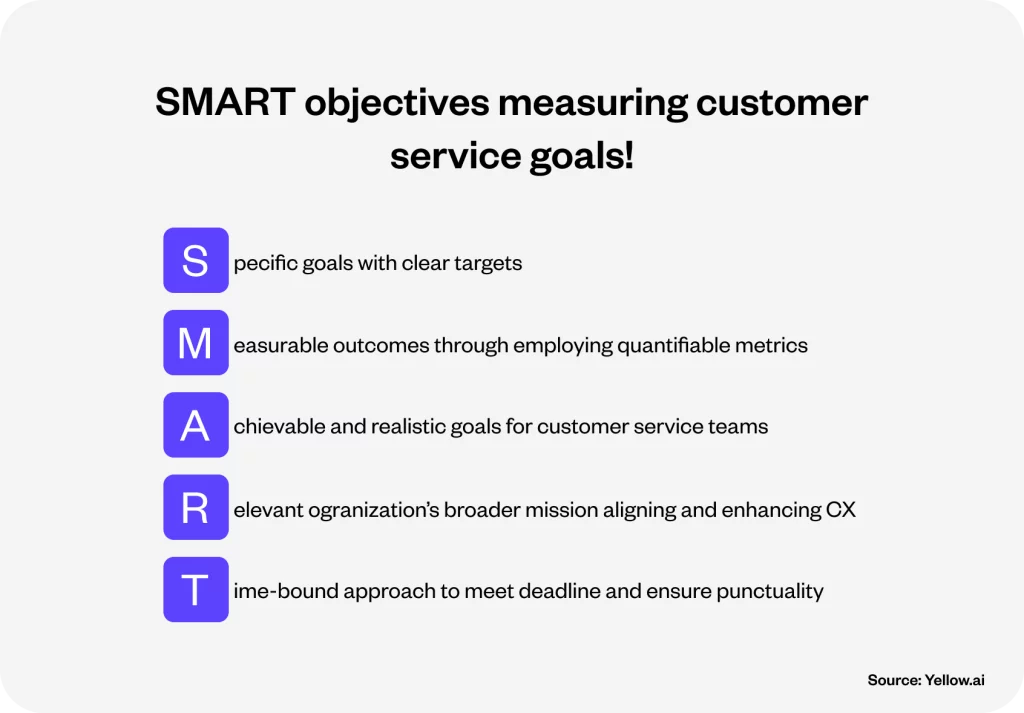
SMART objectives measuring customer service goals!
- Specific goals with clear targets
- Measurable outcomes through employing quantifiable metrics
- Achievable and realistic goals for customer service teams
- Relevant ogranization’s broader mission aligning and enhancing CX
- Time-bound approach to meet deadline and ensure punctuality
- Specific: Define goals with clarity. For instance, instead of a vague “enhance customer satisfaction,” aim to “achieve a 90% customer satisfaction rate within six months.” This specificity provides a clear target for teams to strive towards.
- Measurable: Employ quantifiable metrics such as response times, resolution rates, or customer satisfaction scores to track progress effectively. Each goal should be tied to a specific, measurable outcome.
- Achievable: For your team, set realistic, achievable goals. This approach challenges the team but remains within reach. Unattainable goals can demotivate staff, while achievable targets foster a sense of accomplishment and progress.
- Relevant: Align goals with your organization’s broader mission and objectives. Ensure each goal enhances the customer experience and advances business priorities.
- Time-bound: Assign a deadline to each goal to instill urgency and focus. Time constraints help prioritize efforts and drive momentum toward achieving the objectives.
2. Data-driven decision making
Utilize analytics and customer feedback to identify improvement areas and set informed goals. Data guides goal-setting and provides a baseline to measure progress and success.
3. Regular monitoring and adjustment
Implement a system for regularly tracking progress against each goal. It could involve weekly or monthly reviews of key performance indicators (KPIs). Be prepared to adjust strategies based on these insights, ensuring continuous alignment with customer needs and business objectives.
4. Integrate goals across teams
Ensure that customer service goals are integrated across different departments and levels within the organization. This holistic approach guarantees that all efforts contribute cohesively towards enhancing customer satisfaction and service excellence.
5. Leverage technology for efficiency
Incorporate advanced tools like CRM systems, analytics platforms, and AI-driven insights to streamline goal tracking and gain a deeper understanding of customer interactions. This technological support can significantly enhance the precision and effectiveness of your customer service strategies.
Customer service goals your team should prioritize
Crafting a customer service strategy that propels your business forward requires pinpointing the most important goals. Here’s a closer look at the top 15 customer service goals your team should prioritize, each underpinned by the imperative to meet and exceed customer expectations:
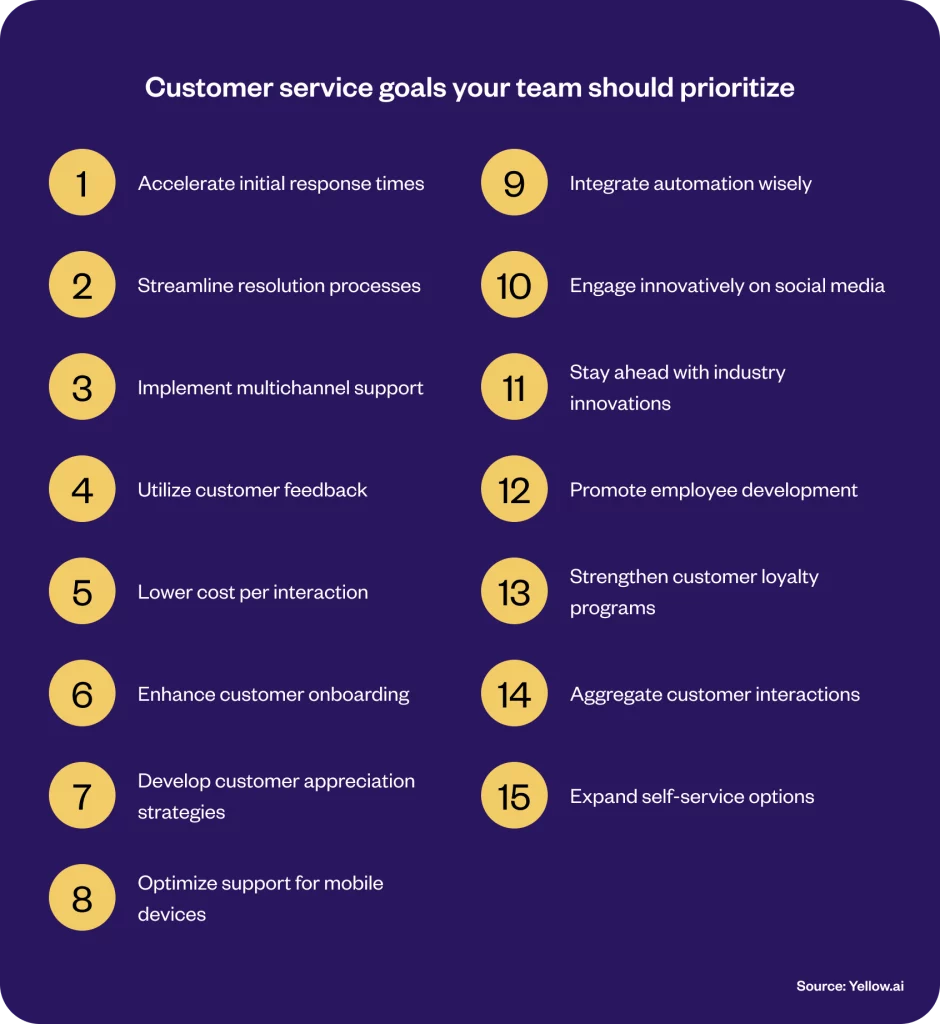
1. Accelerate initial response times
Quick response times set the tone for customer interactions, demonstrating respect for their time and urgency in addressing their needs. Speedy initial contact can significantly boost customer satisfaction and perception of your brand.
2. Streamline resolution processes
Efficient resolution processes mean less time customers spend grappling with issues, leading to increased satisfaction and trust in your service. Streamlining these processes helps in resolving customer queries more swiftly, enhancing overall service quality.
3. Implement multichannel support
Offering consistent and effective support across various channels (phone, email, chat, social media) ensures that customers can reach out in a way that’s most convenient for them, thereby improving accessibility and satisfaction.
4. Utilize customer feedback
Gathering and acting on customer feedback regularly is crucial for continuous improvement. It allows you to understand customer needs better and make informed decisions to enhance service quality and product offerings.
Related read: Customer Feedback: Types + 8 Ways to Collect It
5. Lower cost per interaction
Reducing the cost per interaction without compromising service quality can significantly impact the bottom line. It involves optimizing resources and processes to deliver efficient and cost-effective customer service.
6. Enhance customer onboarding
A smooth onboarding process is crucial in setting customers up for success. It ensures they understand and can fully utilize your products or services, fostering long-term satisfaction and loyalty.
7. Develop customer appreciation strategies
Showing genuine appreciation can strengthen customer relationships. Tailored thank-you notes, rewards, or loyalty programs demonstrate that you value their business and encourage repeat interactions.
8. Optimize support for mobile devices
With the increasing use of smartphones, providing mobile-friendly customer support is non-negotiable. Ensuring your services are accessible and efficient on mobile devices allows you to meet customers where they are.
9. Integrate automation wisely
Automation can streamline repetitive tasks and free up time for complex customer issues. However, balancing automation with human touch is crucial to maintaining personalized and empathetic customer interactions.
10. Engage innovatively on social media
Utilizing social media platforms for customer service allows you to engage with customers in real-time and on a public forum, showcasing your commitment to customer satisfaction and transparency.
11. Stay ahead with industry innovations
Keeping abreast of and integrating the latest industry innovations, like AI and machine learning, can enhance your customer service capabilities and allow you to offer cutting-edge solutions to customer needs.
12. Promote employee development
Investing in employee development ensures that your team has the skills and knowledge to provide exceptional service. Happy, well-trained employees are more likely to deliver quality customer experiences.
13. Strengthen customer loyalty programs
Effective loyalty programs that reward repeat business can help retain customers and turn them into advocates for your brand, enhancing your reputation and customer base through word-of-mouth.
Related read: Customer loyalty: Importance & Strategies to increase
14. Aggregate customer interactions
Centralizing customer interactions in a single platform enhances service delivery efficiency, ensures consistency in customer communication, and enables a holistic view of customer issues for better resolution.
15. Expand self-service options
Providing robust self-service options empowers customers to find solutions independently, often leading to faster resolution times and increased satisfaction while reducing the demand on your customer service team.
Related read: Customer self-service: Importance, examples, and tips
Examples of customer service department goals
Embarking on the journey of setting customer service department goals transforms your team’s approach to customer engagement and operational excellence. Let’s explore examples that illuminate the path to exceptional customer service.
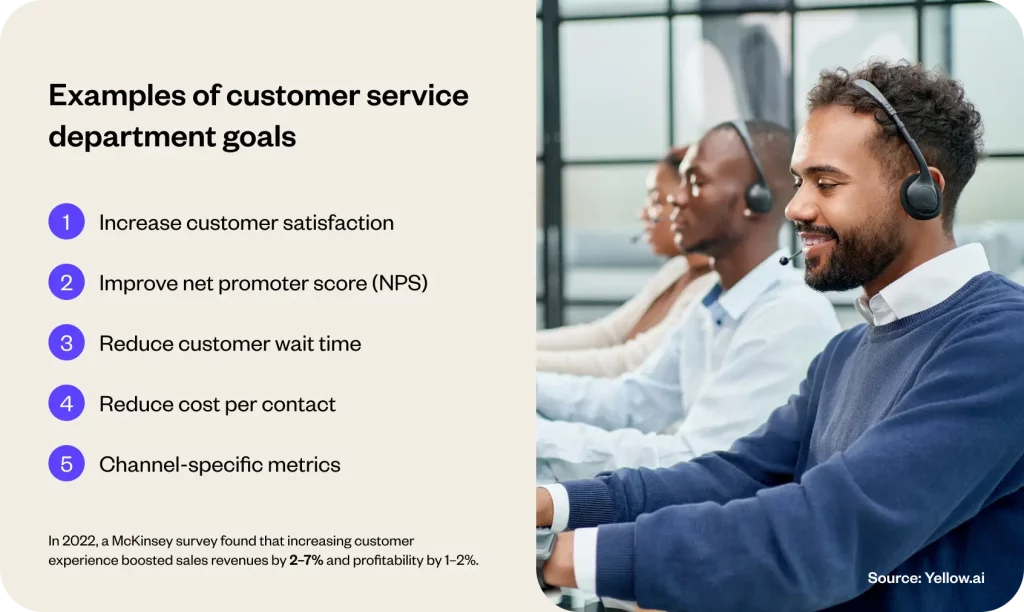
1. Increase customer satisfaction
Customer satisfaction, often encapsulated by the CSAT score, is the cornerstone of customer service excellence. It reflects how well your services meet or exceed customer expectations. High customer satisfaction levels can lead to increased loyalty, repeat business, and positive word-of-mouth referrals.
Satisfied customers are more likely to continue using your services and recommend them to others, directly influencing your company’s growth and reputation.
Measurement: Use post-interaction surveys to gauge customer satisfaction, asking customers to rate their experience on a scale. Calculate CSAT by dividing the number of positive responses by the total number of responses, then multiply by 100.
Goal Example: Aim to improve the CSAT score by implementing targeted training for customer service representatives to enhance their interaction quality.
2. Improve net promoter score (NPS)
NPS gauges customer loyalty and the likelihood of recommending your business. It’s a forward-looking indicator of business growth and customer satisfaction. Improving NPS is synonymous with elevating your brand’s reputation and customer loyalty.
A higher NPS is associated with organic growth through customer referrals and reduced marketing costs.
Related read: 12 Customer Service Metrics to Measure in 2024
Measurement: NPS is calculated based on responses to the question of how likely customers are to recommend your business on a scale from 0 to 10. Subtract the percentage of Detractors from the percentage of Promoters to get your NPS.
- Goal Example: Implement feedback loops and customer engagement strategies to turn Detractors and Passives into Promoters, thus improving the overall NPS.
3. Reduce customer wait time
Minimizing the time customers spend waiting enhances their overall experience and satisfaction. Quick responses are often equated with efficient service and high regard for customer time.
Speedy service can be a decisive factor in customer retention and satisfaction, as modern consumers expect fast and efficient support.
Measurement: Track the average time customers wait before receiving an initial response or complete resolution across different service channels.
Goal Example: Optimize staffing and utilize automated solutions like chatbots to reduce average response time during peak hours.
4. Reduce cost per contact
Balancing high-quality customer service with cost efficiency is vital for maintaining a sustainable business model. Lowering the cost per contact without compromising service quality demonstrates operational efficiency and financial prudence.
Reducing the cost per contact directly impacts the bottom line, allowing resources to be allocated to other areas of customer service improvement.
Measurement: Calculate the cost per contact by dividing the total customer service operational costs by the number of contacts over a specific period.
Goal example: Enhance training programs and implement more efficient technologies to reduce the average cost per contact while maintaining or improving service quality.
5. Channel-specific metrics
Tailoring goals for specific customer service channels ensures that strategies are focused and effective, meeting customers where they are most active and comfortable.
Different channels have unique requirements and customer expectations; excelling in channel-specific service can enhance overall customer experience and satisfaction. In 2022, a McKinsey survey found that increasing customer experience boosted sales revenues by 2–7% and profitability by 1–2%.
Measurement: Set and track metrics like response time, resolution rate, and customer satisfaction for each service channel (e.g., phone, email, social media).
Goal example: For a newly introduced live chat feature, set a target for average response time and monitor chat interactions for customer feedback and improvement areas.
Examples of customer service manager goals
In the realm of customer service, managers play a pivotal role in setting the tone and ensuring exceptional service delivery. Let’s explore the nuanced goals that customer service managers should prioritize to cultivate a thriving service environment and foster a positive team culture.
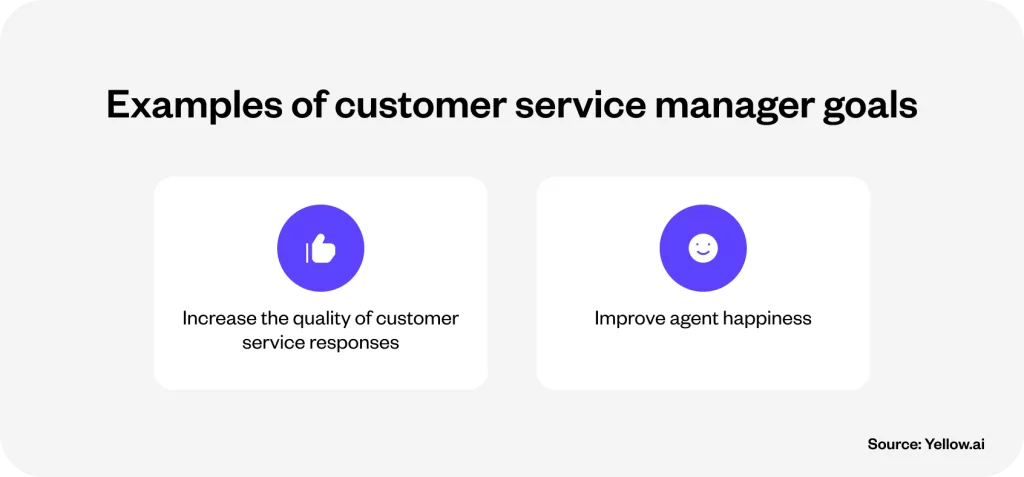
6. Increase the quality of customer service responses
Quality in customer service responses directly impacts customer satisfaction and loyalty. Managers must prioritize enhancing the quality of interactions between agents and customers to ensure consistency and excellence.
High-quality responses resolve customer queries effectively and build trust and rapport, leading to improved customer relationships and increased retention rates.
Implementing a comprehensive quality assurance program, regular training sessions, and feedback mechanisms can significantly better the quality of customer service. Establish clear guidelines and criteria for what defines a ‘high-quality response’. It should also include factors such as completeness, accuracy, tone, and alignment with brand values.
Utilize tools like conversation analysis and customer feedback to gauge the quality of service responses. Regularly review a random selection of interactions based on a predefined quality rubric to score and track improvements over time. For example, aim to enhance the average quality score of service responses from 3.5 to 4.5 over six months through targeted training and feedback.
7. Improve agent happiness
The well-being and satisfaction of customer service agents are integral to the service department’s overall performance. A content and motivated team is more likely to deliver superior customer service and go the extra mile in resolving issues.
Contented agents often exhibit higher productivity, lower absenteeism, and a greater sense of customer empathy, leading to better customer experiences and reduced turnover.
Foster a supportive work environment that values open communication, recognition, and professional development. Regular check-ins, well-being programs, and career growth opportunities can enhance agent satisfaction and engagement.
Employ surveys, like Employee Net Promoter Score (eNPS), to measure agent happiness and collect actionable feedback. Analyze trends in employee turnover and engagement levels to identify areas for improvement. Set a target to improve eNPS by a specific percentage or reduce turnover rates within a defined period, demonstrating a commitment to enhancing the employee experience.
Embracing futuristic customer service

Examples of customer service representative goals
Customer service representatives (CSRs) are the backbone of any customer service team. They interact directly with customers and solve their problems, thus working as the face of your organization. Setting specific goals for CSRs is essential for their personal development and the overall improvement of customer service quality. Let’s delve into two key areas where CSRs can focus their goal-setting efforts to enhance their skills and contribute more effectively to their teams.
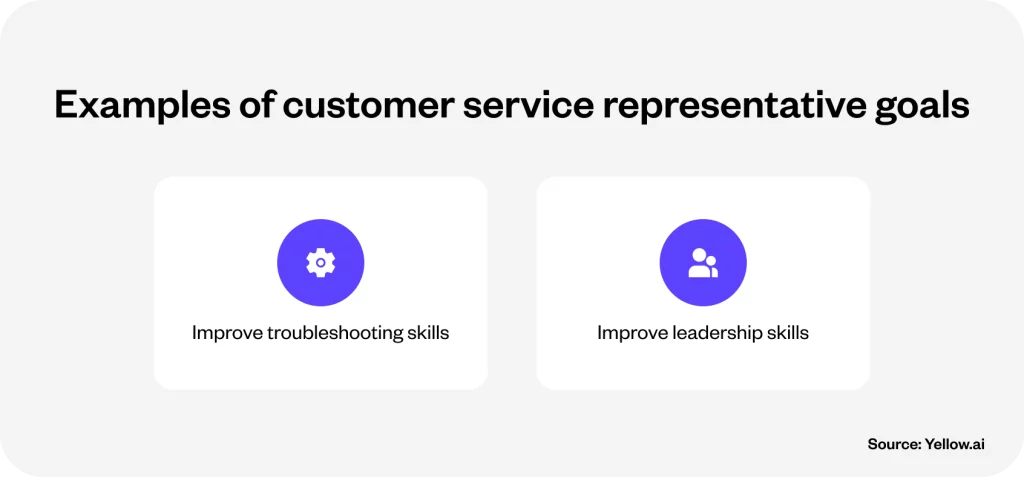
8. Improve troubleshooting skills
Troubleshooting is a critical skill for CSRs, enabling them to diagnose and resolve customer issues efficiently. Honing and improving it can lead to faster resolution times, increased customer satisfaction, and a more proficient use of resources.
Effective troubleshooting reduces the time and effort spent on resolving each customer issue, directly impacting customer satisfaction and loyalty. CSRs with advanced troubleshooting abilities can identify the root cause of problems quickly, propose effective solutions, and prevent recurring issues.
Regular training sessions, participation in problem-solving workshops, and exposure to a variety of customer scenarios are not just theoretical exercises. They are practical tools that can significantly enhance CSRs’ troubleshooting capabilities. Simulated customer service situations and real-life case studies provide hands-on experience and foster analytical thinking, preparing CSRs for real-world challenges.
Set specific, measurable goals for improvement in troubleshooting, such as reducing the average time to resolve complex issues or increasing the accuracy of first-time fixes. For instance, aim to improve the quality score of troubleshooting in service reviews from 70% to 85% within six months, indicating a more adept and efficient problem-solving approach.
9. Improve leadership skills
Leadership skills are essential for CSRs who aim to advance their careers, take on more responsibilities, or lead by example within their teams. Developing these skills can help them manage tasks more effectively, inspire colleagues, and contribute to a positive team culture.
Strong leadership skills in customer service representatives can lead to better team dynamics, more effective communication, and improved problem-solving. Leaders within the CSR team can mentor new team members, manage small projects, and drive initiatives that enhance team performance and customer satisfaction.
CSRs can develop leadership skills through various avenues. They can participate in mentorship programs, take the lead in team meetings, or manage customer service projects. Furthermore, they can explore roles that require coordination and team management, such as becoming a team lead or a project manager, which can be stepping stones for career advancement.
Establish goals focused on developing and demonstrating leadership qualities. For example, a CSR could aim to successfully lead a team project to improve a specific aspect of the customer service process or to receive positive feedback from peers and supervisors on leadership in customer interactions.
The final thoughts
Setting and achieving the right goals in the customer service domain is not just about meeting benchmarks; it’s about crafting experiences that resonate. These tools foster relationships that endure and drive a culture of continuous improvement. As we navigate the evolving landscape of customer expectations, we must leverage advanced solutions that seamlessly integrate with our strategies, ensuring every customer interaction becomes an opportunity to impress and retain them.
Yellow.ai can be your best ally in this regard, as our cutting-edge AI-driven technologies promise to revolutionize how businesses handle customer service. With robust analytics and automation capabilities, Yellow.ai stands as a beacon of innovation, offering tools that enhance the efficiency of service delivery and provide insights that drive strategic decisions. By adopting solutions like Yellow.ai, businesses can transcend traditional service paradigms, setting new standards of excellence that align with the aspirations of the modern customer.




















